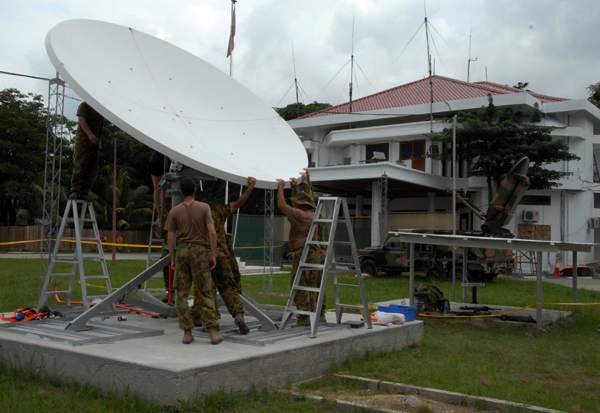Camp Phoenix
Introduction
Located in the Dili suburb of Caicoli, Camp Phoenix is the headquarters for the International Stabilisation Force and for the Australian and New Zealand Defence Force’s Joint Task Force 631 as part of Operation Astute. The base came under attack on 7 February 2008.
Camp Phoenix, Dili

Source: Aerial images of Dili, Op Astute Images, 06 October 2006,
Operation Astute, Department of Defence

Source: Operation Astute Images, 19 January 2007, Installation of SATCOM terminal.
Members from 110 Signal Squadron, install a satellite communications terminal to provide communication services for Joint Task Force 631 at Camp Phoenix, Dili.
Government sources
Townsville Battalion groups hand over in Timor, Operation Astute Images, Department of Defence, 9 October 2007.
“The International Stabilisation Force (ISF) and 2nd Battalion, the Royal Australia Regiment (2 RAR) flags have been raised together to signify the rotation of Timor Leste Battle Group responsibilities during a small ceremony at the force’s headquarters at Camp Phoenix in Dili. The 2 RAR Battle Group, known as SAMICHON, has replaced the 1st Battalion, the Royal Australia Regiment (1 RAR) which has completed a six-month tour in Timor Leste. While based on 2 RAR, the Battle Group also includes elements from 4th Field Regiment, 7th Battalion, 3rd Combat Engineer Regiment, 3rd Combat Service Support Battalion and the 1st Military Police Battalion.”
Commentary and analysis
7 February 2008 attack
Blast hits Australian troop base in Dili, The West Australian, 8 February 2008
“Investigators have found the exact location of an explosion at an Australian base in East Timor but haven’t yet determined the cause. Defence spokesman Brigadier Andrew Nikolic said he could not speculate on the cause of the blast about 8pm local time on Thursday at Camp Phoenix, the main base for Australian and New Zealand troops. No one was hurt.”
See also
Updated: 17 June 2009

